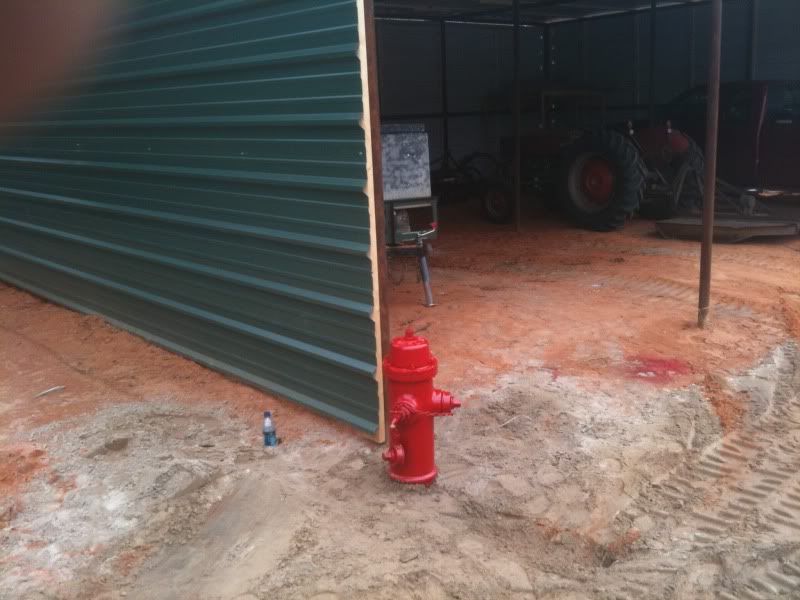Well, in my city, we've replaced a lot of fire plugs lately. Other than scrap, there's not much else you can do with an old fire plug as it probably doesn't work any more. The one I got from the city was taken out of service at the ripe old age of 100 years. It's a 1909 Darling and was in very poor shape but I could see the old diamond in the rough sort-of-speak.
Anyway, so this weekend we laid a new water line from the house to the new barn we built that I showed pix of a few weeks back. We rehabilitated the old fire hydrant, ground all of the old paint and rust off, took some parts out of, and ran one of the lateral lines off of the main water line for a spigot. Below is what it finally looked like. I thought is was way cool and really not all that tough. The toughest part was getting the old bolts out (impact wrenches are way cool even though we had to cut one with a torch) and cutting a hole in the base so the pipe could go through (my tip wasn't nearly big enough to cut effectively 3/4" cast iron).

I've seen many this old and older that still work just fine. No reason for them to go bad or to become inoperative. Usually it's the to small water line that needs replacing because of inadequate flows.
The main reason to replace your Darling would be that it has no 5 1/4" steamer. Most current fire equipment regulates the pressure from the pumper truck instead of the line itself. It's a lot easier on the water lines and you get less breaks when the plugs are used.
> I've seen many this old and older that still work just fine. No reason for them to go bad or to become inoperative. Usually it's the to small water line that needs replacing because of inadequate flows.
>
> The main reason to replace your Darling would be that it has no 5 1/4" steamer. Most current fire equipment regulates the pressure from the pumper truck instead of the line itself. It's a lot easier on the water lines and you get less breaks when the plugs are used.
Oh we still have some that are in service. This one was right by the fire house that got worked a lot, say twice a week for umpteen years.
As far as the 5" steamer connection, we have 2 1/2 to 5" adapters for our fire trucks. Not as good, but it works when the house is burning. Yes, our trucks measure the hydrant pressure but we boost it, just not enough to draw a vacuum (Have you ever seen a 5" line totally sucked down like a straw? Very cool, but not cohesive to fighting fire.)
I've seen lines sucked down but mostly they were very inadequate to begin with. We have been spending about 3 mil a year for several years to replace all our older four inch lines and we even found some two inch lines in the older parts of town.
No plug is going to help when you just don't have enough flow in the lines.
Our fire department does twice a year testing (gpm,pitot,static) and they break a lot of lines because of being in a rush and creating a water hammer. Used our GIS with locations, dates and breaks to show the Chief that our breaks went up 75% when they were testing. They got a LOT better after that with slowing down when using the operating nut.
LOL! I bet so!
You should keep one in the back of your truck, just in case you need something to set a benchmark on.
😉
Well, I've thought of that, but we always keep on on the fire trucks in case we need water pretty badly.
🙂
Looks good! I've go a sudden urge to go to the 'little surveyor's room'!;-)
CV
way cool Kris.
someone will be along soon to explain why that hydrant is not properly engineering to survive a windy day.
You should watch your step around it in case any dogs have been in the area. There may be a pungent odor!



